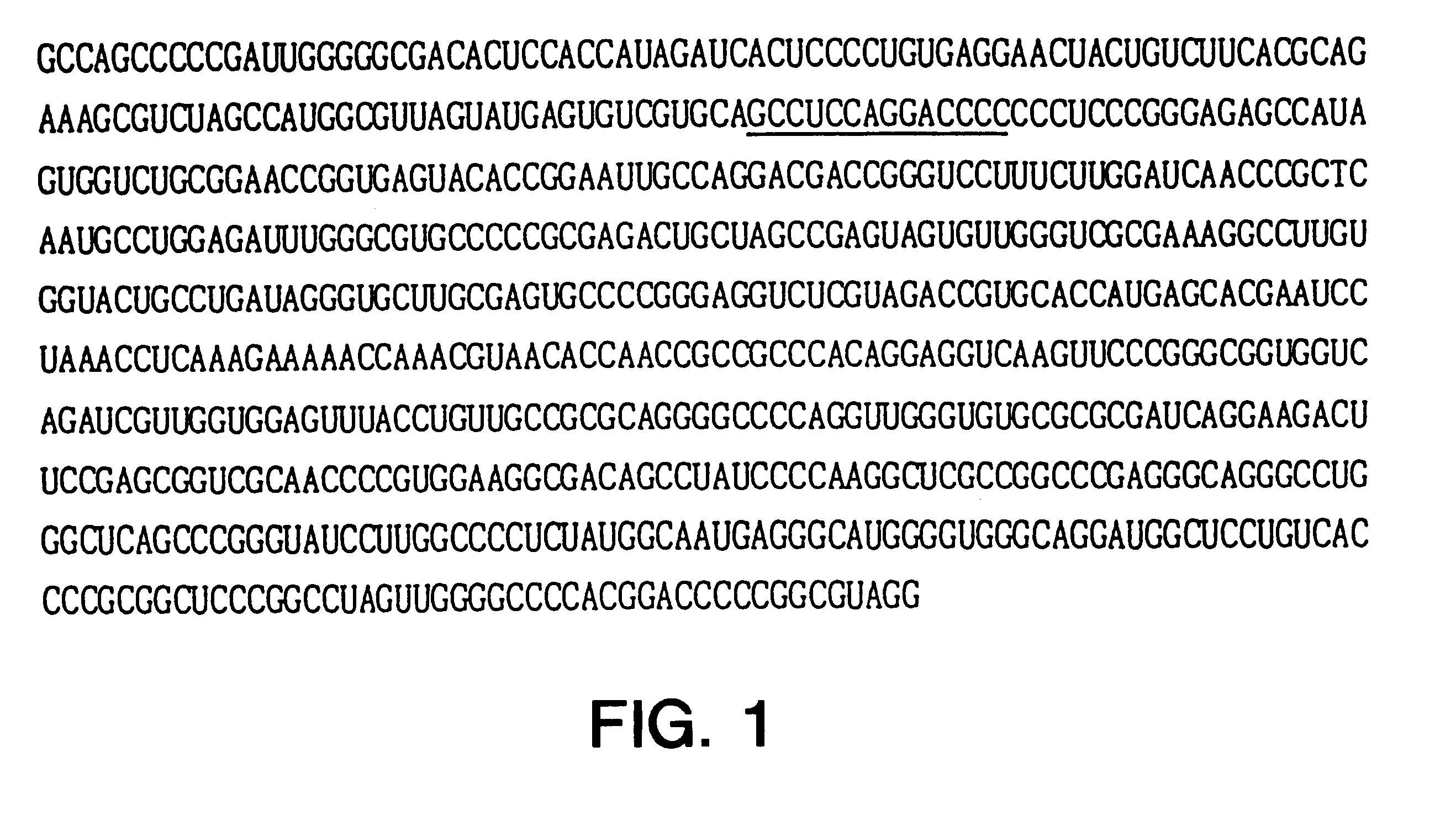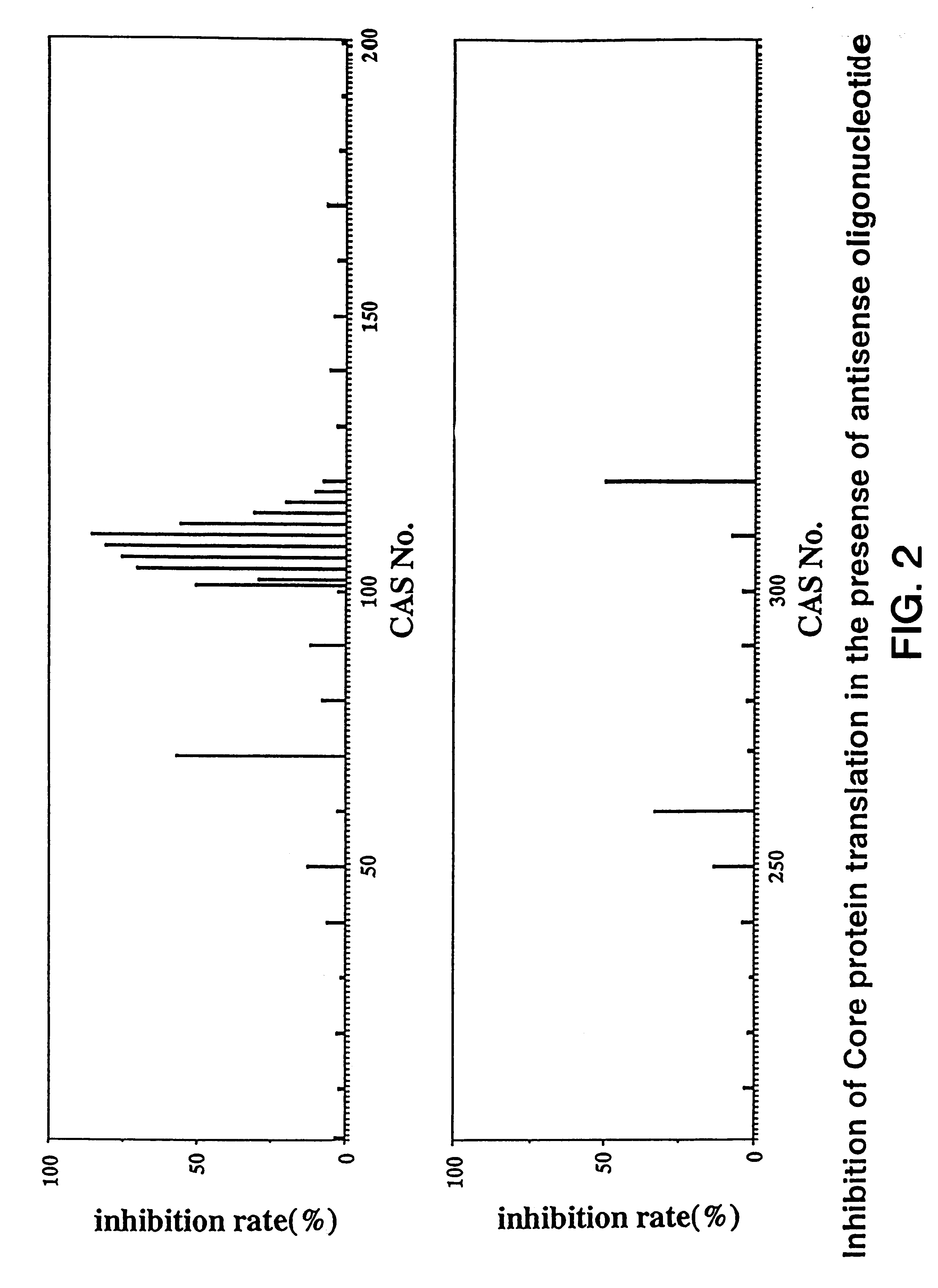Compositions and methods for treatment of hepatitis C virus-associated diseases
a technology for hepatitis c virus and compositions, applied in the field of compositions and methods for treating hepatitis c virus-associated diseases, can solve the problems of significant problem of chronic active nanbh, achieve enhanced cellular uptake, improve stability, and facilitate the determination of optimal dosages
- Summary
- Abstract
- Description
- Claims
- Application Information
AI Technical Summary
Benefits of technology
Problems solved by technology
Method used
Image
Examples
example 1
Oligonucleotide Synthesis
Unmodified DNA oligonucleotides were synthesized on an automated DNA synthesizer (Applied Biosystems model 380B) using standard phosphoramidite chemistry with oxidation by iodine. .beta.-cyanoethyldiisopropyl-phosphoramidites were purchased from Applied Biosystems (Foster City, Calif.). For phosphorothioate oligonucleotides, the standard oxidation bottle was replaced by a 0.2 M solution of 3H-1,2-benzodithiole-3-one 1,1-dioxide in acetonitrile for the stepwise thiation of the phosphite linkages. The thiation cycle wait step was increased to 68 seconds and was followed by the capping step.
2'-O-methyl oligonucleotides were synthesized using 2'-O-methyl .beta.-cyanoethyldiisopropyl-phosphoramidites (Chemgenes, Needham Mass.) and the standard cycle for unmodified oligonucleotides, except the wait step after pulse delivery of tetrazole and base was increased to 360 seconds. The 3'-base used to start the synthesis was a 2'-deoxyribonucleotide.
2'-O-propyl oligonucl...
example 2
Transcription and Translation of HCV RNA in Genetically Engineered Cells
A recombinant DNA vector capable of expressing HCV genes in mammalian cells is constructed using standard genetic engineering methods. A cDNA fragment representing the HCV mRNA or genomic transcript is placed behind an inducible eukaryotic promotor such as the LTR from mouse mammary tumor virus in such a way that transcription of the HCV cDNA begins at the appropriate nucleotide position. At the 3' end of the gene, a polyadenylation signal is incorporated to ensure termination at the appropriate nucleotide position. It may be advantageous to modify the coding sequence by insertion of an in-frame reporter domain (e.g., the enzymatically active domain of the firefly luciferase gene) which can simplify detection procedures for expression of the fusion protein. The vector also contains one or more selectable genetic markers such as neomycin resistance.
The described vector is introduced into mammalian cells using a s...
example 3
Evaluation of Antisense Oligonucleotide Inhibition of HCV Gene Expression from Genetically Engineered Cells
Mammalian cells transfected with expression vectors such as those described in Example 2 are incubated overnight in medium containing antisense oligonucleotides. After oligonucleotide treatment, cells are treated with dexamethasone in order to induce expression of HCV gene products. After a suitable incubation period (4-24 hours) cells are harvested, and expression of specific HCV polypeptide can be detected immunologically using specific antisera in a western blot or immunoprecipitation assay. If the cells contain a vector containing a reporter domain, such as that for firefly luciferase, fused in-frame with the HCV polyprotein, cell extracts can be harvested and evaluated for enzymatic activity of the reporter domain.
PUM
| Property | Measurement | Unit |
|---|---|---|
| concentration | aaaaa | aaaaa |
| pH | aaaaa | aaaaa |
| pH | aaaaa | aaaaa |
Abstract
Description
Claims
Application Information
 Login to View More
Login to View More - R&D
- Intellectual Property
- Life Sciences
- Materials
- Tech Scout
- Unparalleled Data Quality
- Higher Quality Content
- 60% Fewer Hallucinations
Browse by: Latest US Patents, China's latest patents, Technical Efficacy Thesaurus, Application Domain, Technology Topic, Popular Technical Reports.
© 2025 PatSnap. All rights reserved.Legal|Privacy policy|Modern Slavery Act Transparency Statement|Sitemap|About US| Contact US: help@patsnap.com



